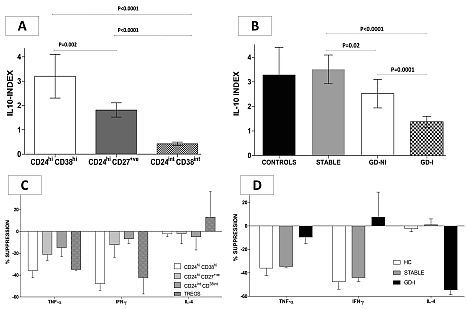Human Regulatory B Cells (BRegs) Are Characterised by Both IL-10 and TNF-α Expression and Are Reduced in Numbers with Altered Function in Renal Transplant Recipients with Immunological Graft Injury
St.James's University Hospital, Leeds, United Kingdom
UCL, London, United Kingdom
UPMC, Pittsburgh
Meeting: 2013 American Transplant Congress
Abstract number: D1456
Human Bregs are defined by their ability to express IL-10 and suppress T cells in vitro. We noted that putative Breg subsets also produce pro-inflammatory cytokines, a finding that has not previously been addressed. Moreover, the clinical significance of Bregs in human organ transplantation remains unclear.
Herein, we define Bregs by the virtue of their polarization towards regulatory (IL-10) or pro-inflammatory (TNF-Α) cytokines by IL-10 Index (Ratio of IL10+ to TNFΑ+ B cells within a specific B subset, relative to the remaining B cells) and study their relevance in renal transplantation. In 18 healthy volunteers IL-10 index distinguished 3 B cell subsets: CD24hiCD38hi (TRS), CD24hiCD27+(MZ), and CD24+CD38+(N). TRS have the highest IL10 index followed by MZ and then N (Fig-1A). In vitro, only TRS significantly suppressed Th1 but not Th2 cytokine expression by autologous mitogen stimulated CD4 T cells (Fig-1C). These B cell subsets were then analysed in renal transplant recipients-Stable: stable graft function (n=45); GD-NI: graft dysfunction-non immunological (n=22); GD-I: graft dysfunction-immunological (n=25). We observed a significant reduction in TRS in the PBMCs of GD-I vs. other groups. Moreover TRS cells when present in GD-I group exhibited a significantly lower IL-10 index suggesting a relative polarization towards an inflammatory cytokine phenotype (Fig-1B), and were unable to suppress Th1 cytokines. They infact suppressed Th2 cytokines whcih was a reversal of their function in comparison to healthy volunteers or stable patients (Fig-1D).
We have characterised the heterogeneity of Breg profiles by both pro-inflammatory and suppressive cytokines. Compared to other B cell subsets, TRS cells have the most suppressive phenotype and correlate with stable allograft function in renal transplant recipients. Immune mediated damage is associated with reduced number of Bregs and pro-inflammatory functional changes. To conclude, Bregs correlate with stable renal allograft function.

To cite this abstract in AMA style:
Cherukuri A, Salama A, Carter C, Clark B, Rothstein D, Baker R. Human Regulatory B Cells (BRegs) Are Characterised by Both IL-10 and TNF-α Expression and Are Reduced in Numbers with Altered Function in Renal Transplant Recipients with Immunological Graft Injury [abstract]. Am J Transplant. 2013; 13 (suppl 5). https://atcmeetingabstracts.com/abstract/human-regulatory-b-cells-bregs-are-characterised-by-both-il-10-and-tnf-expression-and-are-reduced-in-numbers-with-altered-function-in-renal-transplant-recipients-with-immunological-graft-inj/. Accessed December 18, 2025.« Back to 2013 American Transplant Congress
